Telangana TSBIE TS Inter 1st Year English Study Material Grammar Information Transfer Exercise Questions and Answers.
TS Inter 1st Year English Grammar Information Transfer
Q.No. 20 (1 × 4 = 4 Marks)
Information can be expressed through verbal (description) and non verbal (diagrams) modes. Some of the non-verbal modes are :
- Pie-charts,
- Bar graphs,
- Tree diagrams,
- Flow charts and
- Tables.
The process of changing a text from Verbal to Non-verbal mode or vice versa is called Information Transfer. This is a very useful and important skill for students. Acquiring this skill enables the students make notes quickly, understand various texts effectively and present ideas clearly and briefly.
Non-verbal expressions are remarkable for their brevity, clarity, simplicity, accessibility and provision for comparative, contrastive and analytical studies.
1. PIE-CHARTS
A pie-chart is a circle divided into parts. Each part represents a particular thing. And eah part is in proportion to the ratio of that thing to its total. Studying the given pie chart slowly helps one understand the information given there. Then the information can be presented in verbal mode. Once the mode of representing the given information in the form of a pie-chart is understood, verbal text can be transferred into a pie-chart.
In a pie charl; the information is presented in the form of a circle. The circle is divided into sections called sectors. The contribution of each unit in the chart is represented in percentages.
Example 1 :
The following pie chart depicts the results of a survey regarding distribution of different Blood Groups in a college.
Blood Groups in a College
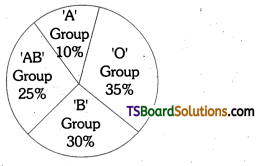
From the figure we can see that 35% of the students of a college have 0 Group of Blood and these students form the largest group. The next largest group comprises students with B Group of Blood. 30% of students belong to this category. 25% of students have AB Group of Blood. Finally, we see that only 10% of students have A Group of Blood. Thus, from the piechart we can conclude that while many students have O Group of Blood. Very few have A Group.
Example 2 :
The following piechart depicts the favourite subject of students in a class. We can see from the figure that five subjects have been taken into consideration – Economics, Civics, Commerce, English and 2nd Language. Students who like Economics form the largest group. A quarter of the students of the class i.e 25% expressed preference for this subject. 20% of the students like English and the same percentage i.e 20% of the students like Commerce. Next in popularity is Civics, liked by 18% of the class. Finally, trailing closely behind Civics, comes 2nd Language, which is the favourite subject of 17% of the students.
Favourite Subjects of Students
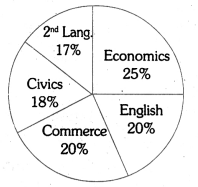
![]()
Exercises and Activities
Question 1.
The following paragraph gives the information about the most widely spoken languages in India. Convert the passage into a pie chart.
Hindi is the most widely spoken language in India. The fact that 44% of Indians speak Hindi across India justifies its title as our National Language. 9% of Indians speak Bengali followed by Marathi which is spoken by 8%. Telugu comes next in the list with 7%, Tamil and Gujarati account for 6% and 5% respectively. All other languages together share the remaining percentage.
Answer:
Pie chart showing languages spoken in India
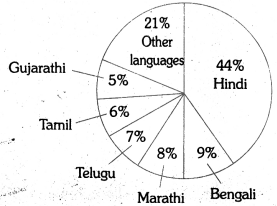
Hindi – 44%
Bengali – 9%
Marathi – 8%
Telugu – 7%
Tamil – 6%
Gujarathi – 5%
All other
languages – 21%
![]()
Question 2.
Read the following paragraph and convert the information into a pie chart.
There are seven continents in the world. Asia is the largest continent with an area of 30% followed by Antarctica with 28%. North America occupies 17% of the land on the earth. South America stands fourth in the list with 12% of land. Africa and Australia are the fifth and sixth largest ones with their respective shares of 6% and 5%. Europe is the last in the list which occupies 2% of the land only.
Answer:
Areas of Continents
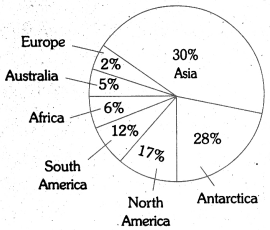
Continents
Asia – 30%
Antarctica – 28%
North America – 17%
South America – 12%
Africa – 6%
Australia – 5%
Europe – 2%
Question 3.
Observe the pie chart given below. It contains information about the mode of transport used by students of a certain junior college. Write a small paragraph.
Mode of Transport of Students
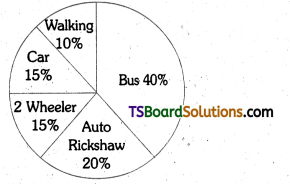
Answer:
Mode of Transport of Students
The given pie chart presents the mode of transport used by students of a particular junior college. A major part of them 40% – use the public transport, i.e. bus. A half of the share of bus, that is 20% of them travel by autorickshaws. Two wheelers and cars carry 15% each of the students. Just 10% of them use the cleanest and the healthiest mode – walking.
![]()
Question 4.
The pie chart given below shows how people spend their time on smart phones. Convert the information into a paragraph.
Time spent on Smart. Phones
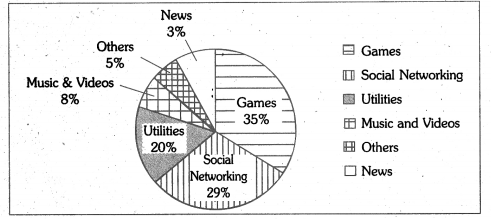
Answer:
Time spent on Smart Phones
Time spent on smart phones is presented in the given pie chart. The lion’s share, i.e. 35% of the time goes to games. Social networking follows games with its share of 29% of the time. Utilities Consume 20% time. The share of music and videos is 8%. Others take 5% time. News comes last with just 3% time.
2. BAR BRAPHS
A bar graph is a diagram in which values of variables are shown by the length of rectangular columns with equal width. It is another visual representation of data. It helps to compare the values presented in a group. The bars can be plotted vertically or horizontally. A vertical bar chart is sometimes called a column bar chart.
Example 1 :
Given below is the iar graph that shows the cost of certain vegetables over a period of 4 months. Let us now make a detailed analysis.
The bar graph given below shows the cost of carrots and potatoes over a period of four months – January, February, March and April. Carrots were more costly than potatoes during all the months. In January carrots cost Rs. 35 a kilo, while potatoes cost a little less, at Rs. 30 a kilo. The cost of carrots increased to Rs. 40 in February, while there was a sharp fall in the cost of potatoes.
There was a sharp rise in the cost of both the vegetables after that and in March the cost of carrots was Rs. 50 per kilo while that of potatoes was Rs. 40. In April once again there was a steep increase in the cost of carrots but the cost of potatoes remained the same as in March. Thus we observe that the cost of carrots kept increasing over the months but that of potatoes fluctuating.
COST OF VEGETABLES (in Rs per kg)
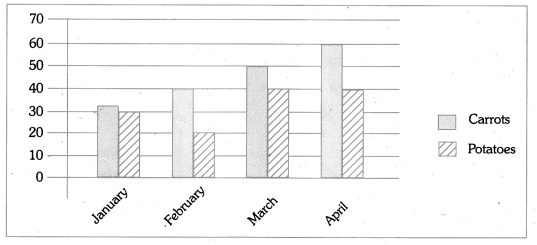
![]()
Example 2 :
The following bar graph represents the favourite sports of various group of students studying in a college. Students of four sections HEC, CEC, BPC and MPC were asked about their preferences in sports. The number of students in each section varied. Three sports were considered – football, cricket and kabaddi. HEC students expressed great interest in cricket. 50 out of 85 students, i.e. more than half liked cricket. Very few in that section, just 5, were fond , of football. 30 liked kabaddi.
In the CEC section, consisting of 100 students, an equal number of students, i.e. 40 liked kabaddi and cricket. 20 liked football. With regard to the science sections, cricket was more popular among BPC students. An equal number in both the sections, 30, were fond of football. The figures for kabaddi too were more or less the same. The BPC section consisted of 88 students while MPC students were 75 in number. On the whole, one can conclude that cricket is the most popular sport in the college, followed by kabaddi.
FAVOURITE SPORTS OF STUDENTS
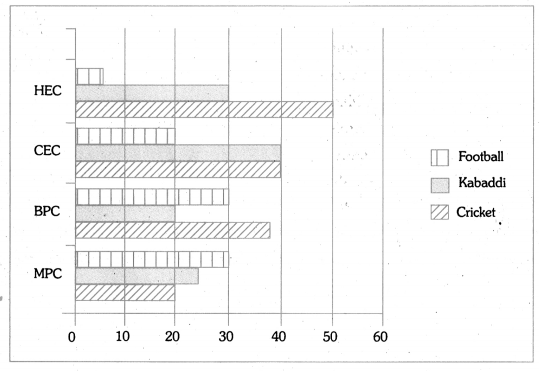
Exercises And Activities
Question 1.
The passage below represents the data of improvement of English language skills due to Internet usage. Present it in a bar graph.
Internet plays an important role in improving Reading skills. 94% participants in this study agreed that they improved their Reading skills by using Internet while 91% opined that they improved Translation skills. Internet usage helped 87% of participants in enhancing their vocabulary skills. 80% of participants unanimously agreed that they improved their Writing skills, Speaking skills and Grammar.
Answer:
Bar Graph Showing Skills due to Internet Usage
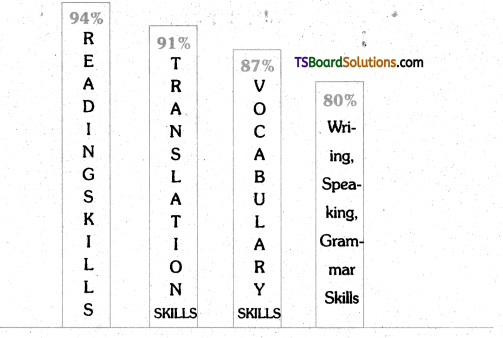
Question 2.
The following passage shows the favourite sports of the students of a school. Represent the data in a bar graph.
Cricket is the most favourite sport of the students which is liked by 80 students. Tennis falls behind Cricket with a slight difference. It is the favourite of 75 students. Swimming and Football are liked by 40 and 45 students respectively while Badminton is the favourite of 30 students. Hockey is the least favouring sport of the students which is liked by 20 students only.
Answer:
Bar Graph Showing Favourite Sport of Students
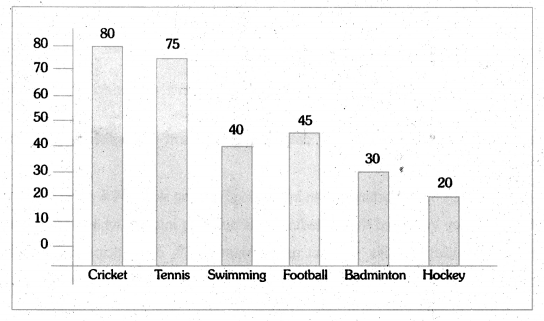
![]()
Question 3.
Analyse the bar graph given below and write about it in a paragraph.
MARKS OF STUDENTS
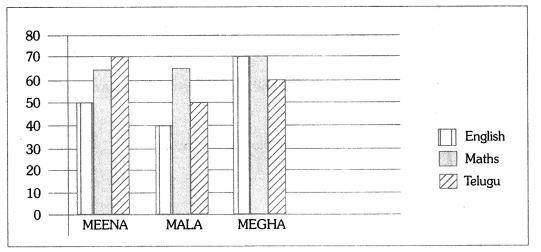
Answer:
The bar chart presents marks of three students in three subjects. Meena scored 70 in Telugu, 65 in Maths and in English just 50. Mala scored 65 in Maths, 50 in Telugu and only 40 in English. Megha secured 70 each in English and Maths but scored 60 in Telugu.
Question 4.
The given below bar graph shows how much dietary fibre is found in certain fruits. Convert the information into a paragraph.
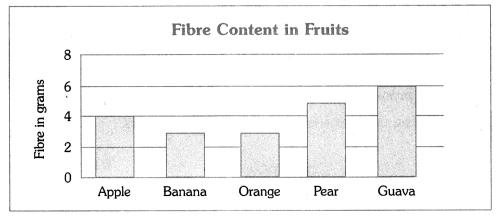
Answer:
Fibre Content in Fruits
The given bar graph presents the details of fibre content in various fruits. The guava stands tall with six (6) grams of dietary fibre per a serving of one cup. Next comes the pear with five (5) grams per unit. The third in the order is the apple with four (4) grams per a cup. The banana and the orange have almost the same quantity of dietary fibre – three (3) grams per cup.
![]()
3. TREE DIAGRAMS
A tree diagram is another way of representing information. It has a branching tree-like structure. It shows how its components are related to one another. It helps us understand the relevant information in a short time.
Example 1 :
There are three types of muscle in the human body. They are smooth, cardiac and skeletal muscles. Smooth muscles are controlled by involuntary responses. Examples of smooth muscles are muscles in the digestive tract and blood vessels. The second type of muscle is cardiac muscle. It is also an involuntary muscle. Muscles that cover the heart are examples of cardiac muscles. The third type of muscle is the skeletal muscle. It is controlled by voluntary response. All the muscles attached to the bones such as biceps, deltoid are examples of skeletal muscles.
The above paragraph can be depicted in the form of a tree diagram as follows.
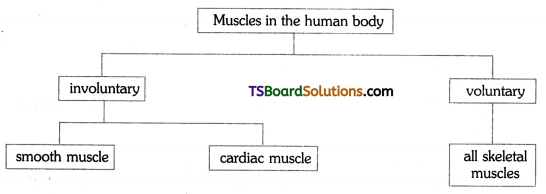
Example 2 :
A man who managed a popular hotel was asked the secret of his success. He said that only when customers were happy with the dining experience would they keep returning to the hotel. Dining would be a pleasant experience only if the food served was of a high standard. Good service too was equally important. He elaborated that food should be tasty and fresh. Service should be prompt and courteous.
Given below is a tree diagram representing the man’s views.
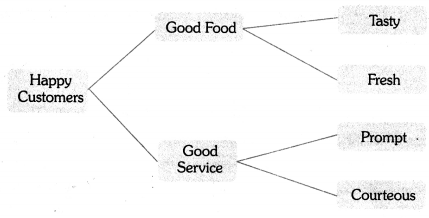
Exercises And Activities
Question 1.
Read the following paragraph and transfer the information into a tree diagram.
The oldest musical instrument in the world is the drum, made initially in one of the three ways. First, frame drums were made by stretching the skin over bowl-shaped frames. Next, rattle drums were made by filling gourds or skins with dried grains, shells, or rocks. Finally, tubular drums were made from hollowed logs or bones covered with skins. Both frame and tubular drums were struck with the hand or with beaters to produce sounds. In contrast, rattle drums were shaken or scraped to make rhythmic sounds. For thousands of years, drums have been used to transmit messages to call soldiers to battle and make music.
Answer:
Tree Diagram showing Types of Drums
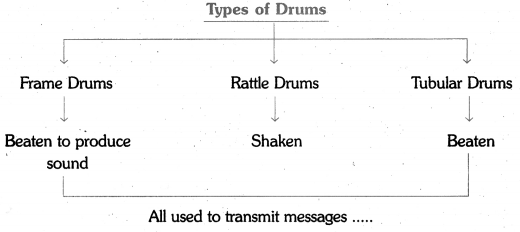
![]()
Question 2.
Read the following paragraph and transfer the information into a tree diagram.
There are so many species of animals that we find living on the earth. Scientists grouped these animals into different classes based on certain similarities they share. Animals are divided into vertebrates, ones with backbones and invertebrates, those without backbones. The vertebrates are basically divided into five classes. They are commonly known as mammals, birds, fish, reptiles and amphibians. Arachnids and insects are the two commonly known classes in the invertebrates group.
Answer:
Tree Diagram showing Species of Animals

Question 3.
The following tree diagram depicts the classification of Vitamins. Present the information in a paragraph.
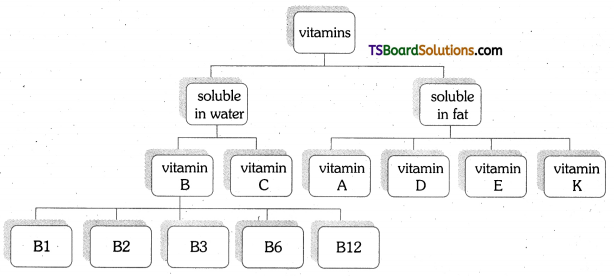
Answer:
Classification of Vitamins
The given tree diagram presents the classification of vitamins. Vitamins are broadly of two types. They are : 1) Soluble vitamins in water and 2) Soluble in fats. Vitamin B and Vitamin C fall in the category of ‘Soluble in water’. Vitamins A, D, E and K (four) belong to the group of vitamins soluble in fat and Vitamin B is sub-divided into Bl, B2, B3, B6 and B12 (five) types.
Question 4.
Study the following tree diagram and write it in a paragraph.
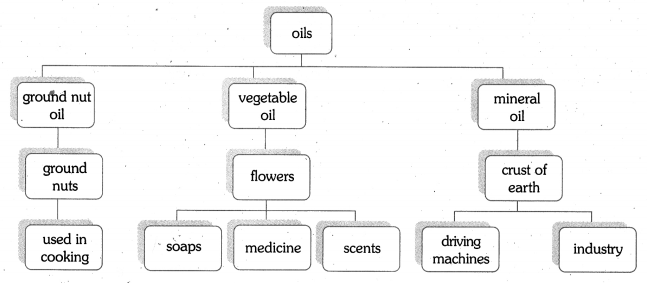
Answer:
Types of Oils
The given tree diagram explains the types of oils. Based on the source, oils are of three categories. They are : 1) Oils from nuts, 2) Oils from vegetation (plants / flowers) and 3) Oils from minerals. Examples are 1) groundnut oil, 2) oils from flowers and 3) oils from the crust of the earth. Groundnut oil is used in cooking. Oils from flowers go into the making of soap, medicines and perfumes (scents). Mineral oil fuels machines and automobiles.
![]()
4. FLOW CHARTS
We draw flow charts when we present information in the form of a process. For instance, we construct flow charts to put the information of the industrial production from raw product to finished product in a logical order in successive steps. Flow charts are simple to construct and easy to understand. Each step in the sequence is written in a diagram shape. These successive stages or steps are linked by connecting directional arrows. They guide readers to understand flow charts logically and follow the process from beginning to end. In these flow charts we find elongated circles, rectangles and diamond shaped diagrams.
Example 1 :
Describe how the following passage is presented in a flow chart. The passage shows the time table for children in a boarding school. You are supposed to wake up at 5 am every day and lights – out time is 9.30 pm. Siesta time is between 1 and 2 in the afternoon. Assembly begins at 8 am sharp in the school hall. You have to report to your House Prefect by 7.30 am on all school days. You may play any game between 4 and 6 pm. You must not be late for study time which is between 6 and 8 in the evening. School timings are from 8.30 am to 3.30 pm with an hour-long lunch break at 1 pm. These details are shown in a flow chart.
Time table of children in a boarding school
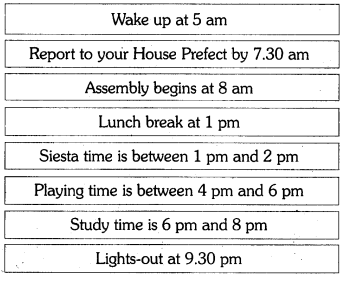
![]()
Example 2 :
Read the following paragraph and transfer the information into a flow chart.
Rayon is a man-made fiber. It is a reconstituted natural fiber – cellulose. Rayon is made by dissolving cellulose in a solution of sodium hydroxide or caustic soda. The cellulose is obtained from shredded wood pulp. The dissolved cellulose is formed into threads by forcing it through a spinneret in a dilute sulphuric acid setting bath. The threads are drawn from the setting bath, wound on a reel, washed, dried on a heated roller, and finally wound onto a bobbin.
Process of Making Rayon
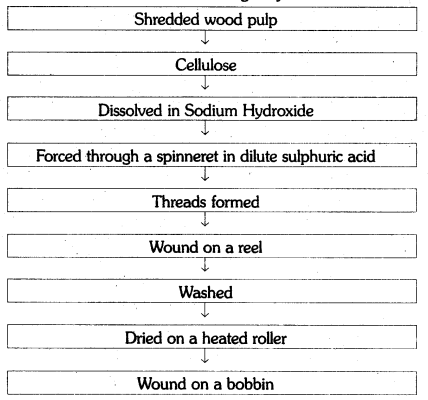
Exercises And Activities
Question 1.
The following paragraph describes how clothes are washed.
Draw a flow chart based on the information given. First, fill a bucket half full with water. Then, add a spoonful of washing powder. Stir vigorously till the power mixes with water and forms foam. Put the unwashed clothes into it. Wait for fifteen minutes. Take out clothes and scrub with a brush to remove stains. Now, rinse the clothes with clean water.
Wring out the clothes gently by twisting and compressing them. This removes excess water from the clothes. This saves the time of drying. Now dry the washed clothes by putting them on the clothes line. Collect the washed and dried clothes later.
Answer:
How to wash clothes ?
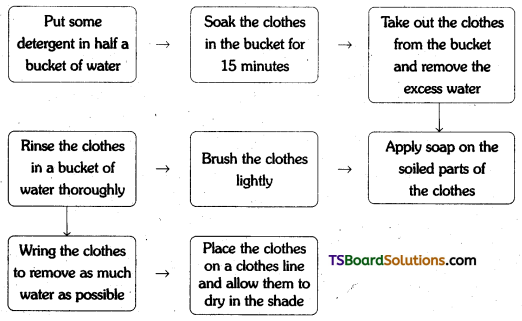
Question 2.
Convert the following paragraph into a flow chart.
Silver occurs in the ores of several metals. The frothing process of extracting silver accounts for about 75% of all silver recovered. Here the ore is ground to a powder, placed in large vats containing a water suspension of frothing agents, and thoroughly agitated by air jets. Depending on the agents used, either the silver-bearing ore or the gangue adhering to the bubbles of the foam is skimmed off and washed. The final refining is done using electrolysis.
Answer:
Flow Chart depicting Frothing Process of Extracting Silver

![]()
Question 3.
The following flow chart describes how paper is manufactured in a paper mill. Write the details in a paragraph.
Manufacture of paper
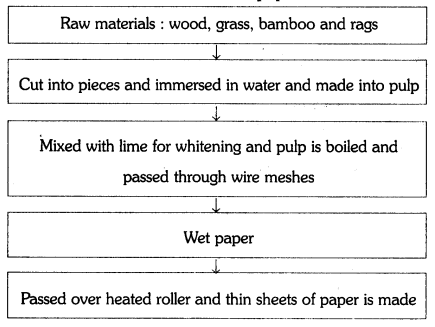
Answer:
The given flow chart describes the process of manufacturing paper. First, the raw materials like wood, grass, bamboo and rags are procured. Secondly they are cut into pieces, immersed in water and made into pulp. Then the pulp is mixed with lime for whitening. Later, the pulp is boiled and passed through wire meshes. At this stage, we obtain wet paper. Finally, it is passed over heated rollers. Then we get the end product, in the form of thin sheets of paper.
Question 4.
Draw a flow chart based on the information given below.
The following process is the description of how a post office transfers a letter from a sender to a receiver. First, the sender posts the letter in a post box. Next, the box is opened. Then the contents in it are sorted out. Then they are kept in a bag and the bag is tied. The destination is written on the bag. The bags are sent to the district post office. The district post office sends the bags to the destination village / town post offices. The destination post office receives the letters. The received letters are arranged and sorted out. The post man delivers the letters to the addressees.
Answer:
Flow Chart depicting the Process of Delivering Letters

![]()
5. TABLES
We can also represent information in the form of a table.
Example 1 :
Given below are the marks secured by Aravind, Akash and Ramesh in their half-yearly examinations of class X.
| Name of the Subject | Aravind | Akash | Ramesh |
| Telugu | 81 | 80 | 81 |
| Hindi | 97 | 97 | 97 |
| English | 60 | 88 | 99 |
| Mathematics | 99 | 97 | 100 |
| Science | 68 | 91 | 98 |
| Social Studies | 95 | 98 | 93 |
After reading the information given in the table we can write a paragraph like this.
In this table, the marks secured by 3 students are compared. While all the three students scored equal marks in Hindi, there is a slight variation of marks in Mathematics and Social Studies. However, there is a great variation of marks in English. From the table it can be concluded that Aravind needs to concentrate more on English and Science, whereas Akash needs to focus on Telugu and English. Ramesh, who scored the highest marks among the three, needs to focus on Telugu.
Example 2 :
The following table shows the number of gold medals won by 8 participating countries in the XII South Asian games 2016. First read the data given in the table.
| Rank | Nation | No. of gold medals won |
| 1 | India | 188 |
| 2 | Sri Lanka | 25 |
| 3 | Pakistan | 12 |
| 4 | Afghanistan | 7 |
| 5 | Bangladesh | 4 |
| 6 | Nepal | 3 |
| 7 | Maldives | 0 |
| 8 | Bhutan | 0 |
![]()
Now read the paragraph given below.
The above table gives the information of the number of gold medals won by 8 participating countries in the XII South Asian games 2016. India secured the first rank with 188 gold metals. It was far ahead of the other countries. Sri Lanka was ranked 2, securing only 25 gold medals. Pakistan got only 12 gold medals and was ranked 3. With 7 golds, Afghanistan is in the 4th place. Bangladesh won 4 golds while Nepal secured just 3 golds. Maldives and Bhutan which stood at the bottom of the table got no gold medals. This table shows the commendable performance of India in the XII South Asian Games.
Exercises And Activities
Question 1.
Read the following paragraph and transfer the information into a table.
A reading test assesses reading comprehension by employing multiple testing techniques, represented by eight main types of questions. Question types, such as Multiple-Choice, Matching, Diagram Labelling, Summary Completion, Sentence Completion, Short Answer Questions with percentage, i.e., 37.50%, 18.13%, 16.25%, 10%, 9.36%, and 8.76%, take place respectively. The number of questions for each of these questions types is variable. Basic English grammar, cloze summary, percentages are although with lower portions and are also considered in the reading test.
Answer:
Table Showing Types of Questions in Reading & Tests
| S.No. | Type of Questions | Percentage |
| 1. | Multiple-Choice | 37.50 |
| 2. | Matching | 18.13 |
| 3. | Diagram Labelling | 16.25 |
| 4. | Summary Completion | 10.00 |
| 5. | Sentence Completion | 09.36 |
| 6. | Short Answer Questions | 08.76 |
| 7. | Basic English Grammar | Negligible |
| 8. | Cloze Summary | Negligible |
![]()
Question 2.
Convert the following paragraph into a table.
There are many elements in the earth’s crust. Oxygen occupies 46%; Silicon 28%; Aluminum 8%; Iron 5%; Calcium 3.6%; Sodium 2.8%; Potassium 2.6%; Magnesium 2%; certain other elements occupy 2% of the earth’s crust. This is what we mean by the abundance of elements in the earth’s crust.
Answer:
Table Showing Elements in Earth’s Crust
| Sl.No. | Name of the Element | Percentage |
| 1. | Oxygen | 46 |
| 2. | Silicon | 28 |
| 3. | Aluminum | 08 |
| 4. | Iron | 05 |
| 5. | Calcium | 3.6 |
| 6. | Sodium | 2.8 |
| 7. | Potassium | 2.6 |
| 8. | Magnesium | 02 |
| 9. | Other elements | 02 |
Question 3.
Study the table below showing a few Asian countries with their capitals and currencies. Write a paragraph containing all the information in the table.
| Country | Capital | Currency |
| Afghanistan | Kabul | Afgani |
| China ‘ | Beijing | Yuan |
| Japan | Tokyo | Yen |
| Saudi Arabia | Riyadh | Riyal |
| Singapore | Singapore | Singapore dollar |
Answer:
The table presents the capitals and their currencies of 5 Asian countries. Kabul is the capital of Afghanistan and their currency is Afgani. China’s capital is Beijing and their currency is Yuan. With Yen as their currency Japan administers the country from Tokyo, the capital city. Saudi Arabia’s capital is Riyadh and their currency is Riyal. Finally Singapore has as its capital Singapore city and their currency is Singapore dollar.
![]()
Question 4.
Look at the following table. It gives information about nutrients (in gms) present in 100 ml. of milk. Present the information in the form of a paragraph.
| Nutrition information about Milk | Per 100 ml approximately |
| Energy (kcal) | 78.0 |
| Fat (g) | 5.0 |
| Carbohydrates (g) | 4.4 |
| As sugar (g) | 0.0 |
| Protein (g) | 2.3 |
| Calcium (mg) | 8.9 |
| Minerals (g) | 0.8 |
Note : k stands for thousand; g stands grammes.
Answer:
The given table provides us information about tire nutrition value of milk. 100 ml of milk gives us 78 kcals of energy. Fat is 5.0 gms. Carbohydrates are 4.4 gms. Sugar Nil. Proteins 2.3 gms. Calcium 8.9 mg. and Minerals 0.8 grams.